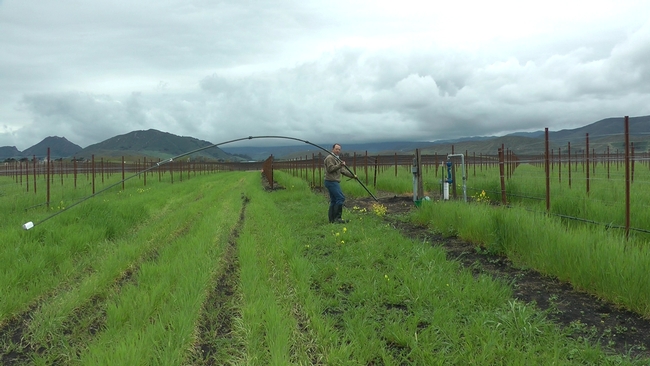
“We’ve had some very severe frosts in San Luis Obispo County and on the Central Coast over the years,” said Mark Battany, UC Cooperative Extension advisor in San Luis Obispo and Santa Barbara counties. “In 2011 we had the most severe frost in 30 years and many millions of dollars of crop and wine value were lost because of that freeze.”
Farmers take various measures to protect their crops when temperatures dip below freezing, such as mowing or tilling the vineyard row middles, or running sprinklers with water pumped from underground aquifers or diverted from streams.
“Sprinkler frost protection is very effective in many areas,” Battany said. “The concern we have in California is that water is becoming more limited. We don’t have the ability to easily import water from other areas to our coastal regions, and our local supplies are being stretched quite thin.”
Some farmers are considering wind machines, which mix warmer air high above the ground with air closer to the ground to raise the temperature. But wind machines are expensive, and the potential effectiveness depends on the strength of the temperature inversion. UC scientists are now gathering data to help inform farmers before making the costly investment.
Battany and his colleagues - Rhonda Smith, UCCE advisor in Sonoma County, Richard Snyder, UCCE specialist in the Department of Land, Air and Water Resources at UC Davis, and Gwen Tindula, UCCE staff research associate - are collecting temperature inversion data at different locations in 60 coastal vineyards throughout three counties to document inversions during frost events.
The scientists installed 35-foot-high meteorological towers with data loggers at the top and at the five-foot height to measure the difference in temperature. In the first year of the study, there were useful inversion conditions on nearly three-fourths of the nights when there was frost.
“That’s a fairly good success rate,” Battany said. “The wind machine will provide quite a bit of protection under those conditions.”
The study will continue this year and in 2014. Farmers who wish to install their own meteorological towers with data loggers can do so at a cost of about $250 each. Installation instructions and specifications are available on the UCCE website.
The UCCE research is funded with a grant from the American Vineyard Foundation and a CDFA Specialty Crops Block Grant.
For more details, see the video below: